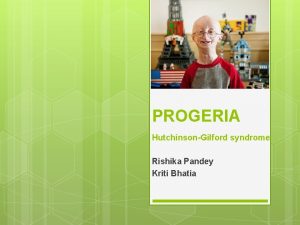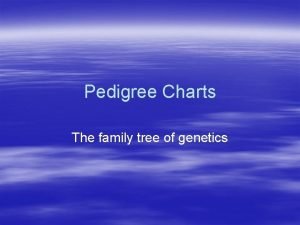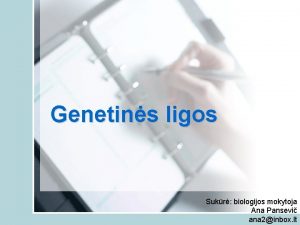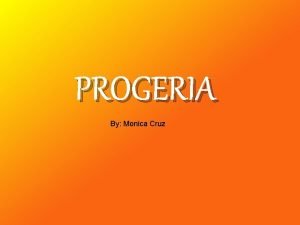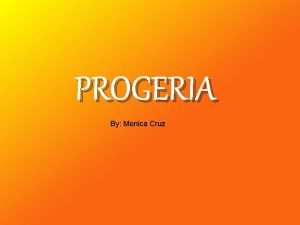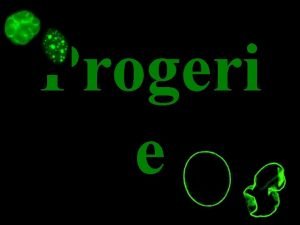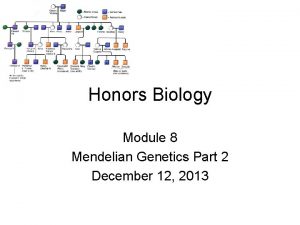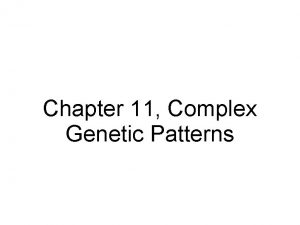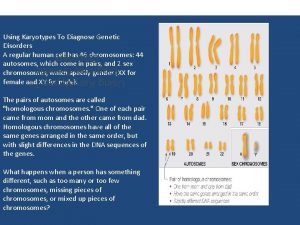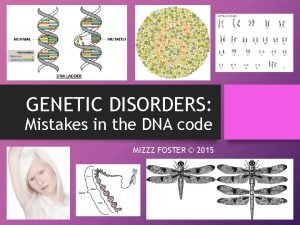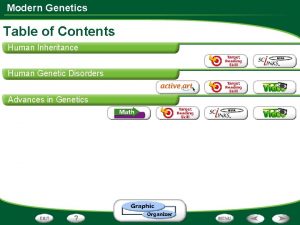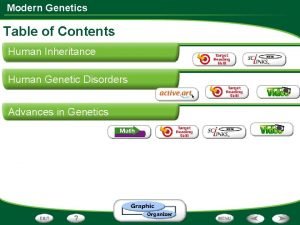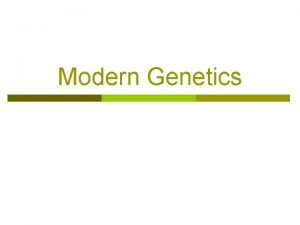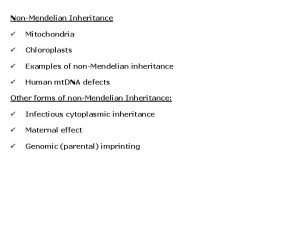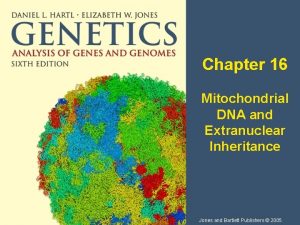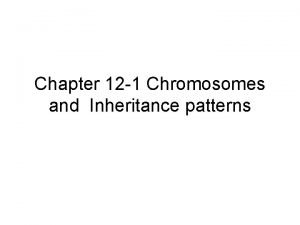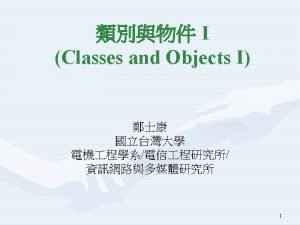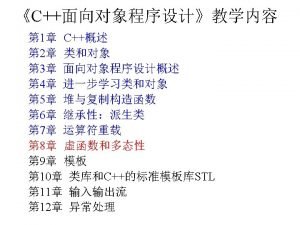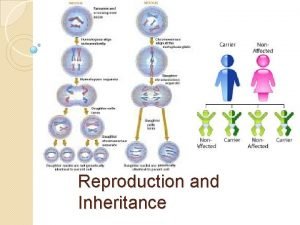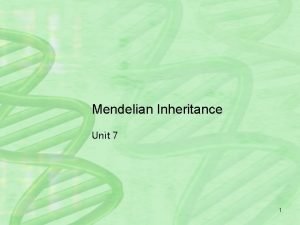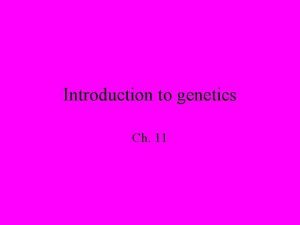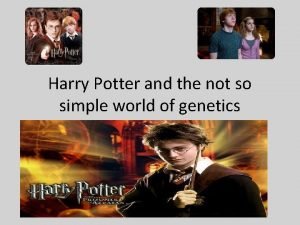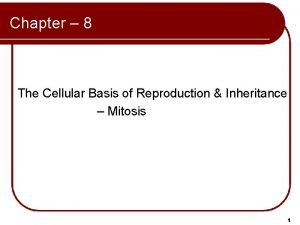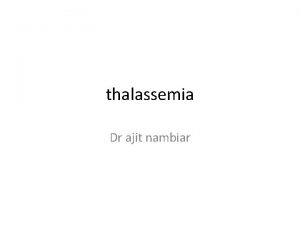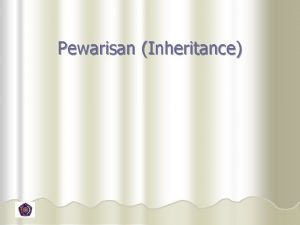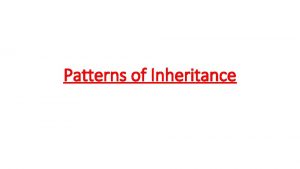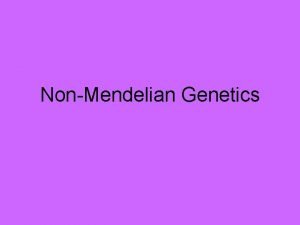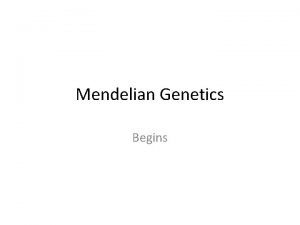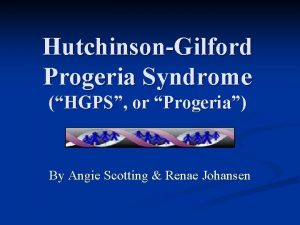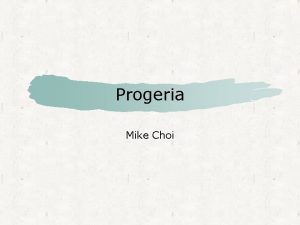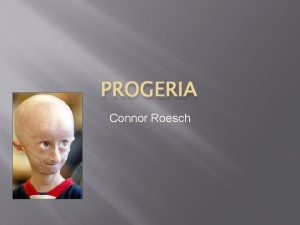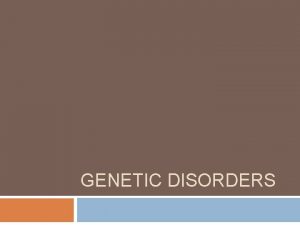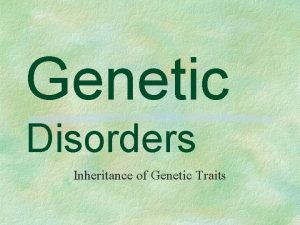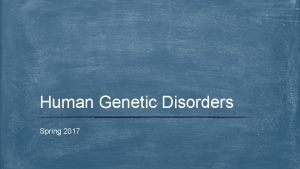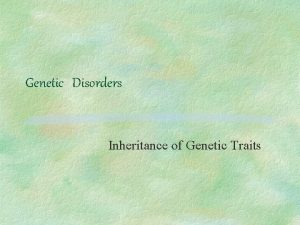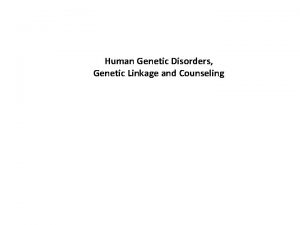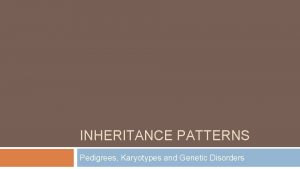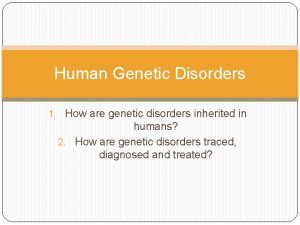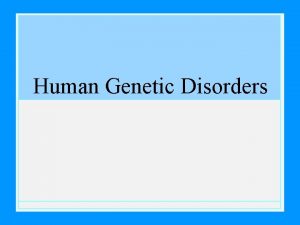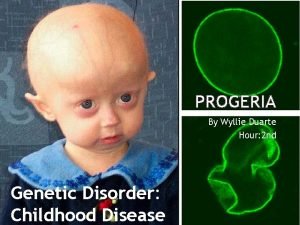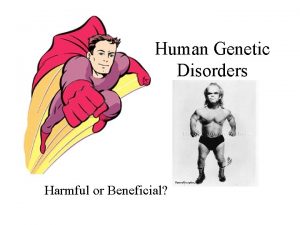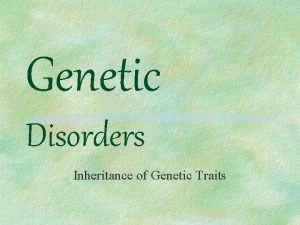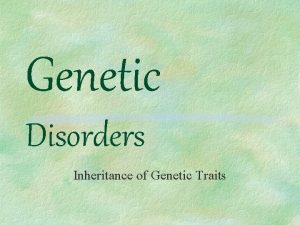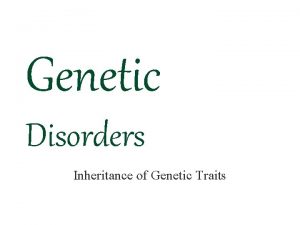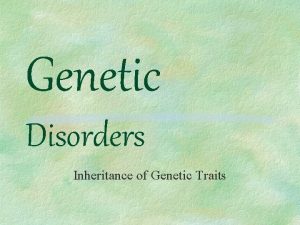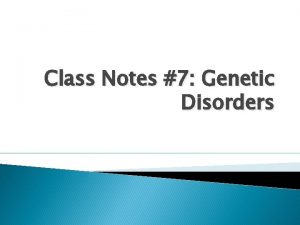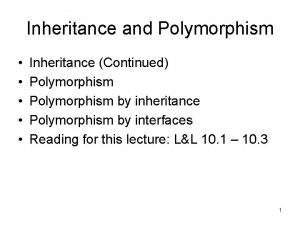Genetic Disorders Human Inheritance and Genetic Disorders Progeria
























































- Slides: 56

Genetic Disorders

Human Inheritance and Genetic Disorders Progeria Polydactyly Hypertrichosis Hemophelia Down Syndrome Sickle Cell Anaemia

INTRODUCTION What is genetic diseases/disorders? The human body is composed up of cells , each one specializing a particular function like sensing light, smelling etc, So the chromosomes which are the sub cellular structure that exist in the nucleus of each cell that makes a human body. There are 23 pairs of chromosomes in human, these chromosomes are responsible for transferring genetic information from one generation to another. Most people have the concept that genetic disease must be the one which is transmitted from one generation to next. Actually this is not totally correct. In medicine genetic disease refers to one that is caused by abnormalities of the genetic material at the stage of germ cells or early embryo.

Pedigrees Geneticists use diagrams that trace the inheritance of particular traits through several generations called pedigrees. A pedigree uses symbols to illustrate different meanings on the pedigree. Males are represented by a square. Females are represented by a circle. Usually someone who expresses a trait is dark. Usually someone without the trait is light. Usually a carrier is half dark and half light.

Pedigrees Horizontal lines between symbols represent parents of the offspring in the lines below them. Offspring are ordered from first to last. Roman numerals represent generations.

Pedigrees A Pedigree is a chart or “family tree” which maps genetic disorders in a family. ●

Karyotypes A Karyotype is a picture of all the chromosomes in a cell. ● Modern scientists can take a blood sample from an unborn child to an adult, create a karyotype by separating chromosomes, and be able to determine if any genetic disorders are present. ● A couple who wishes to have children can receive genetic counselling where a doctor looks at both parents karyotypes to see if any disorders will pass to offspring. ●

ALLELE • Is one member of a pair or series of different forms of a gene. • Homozygous-an organism in which 2 copies of genes are identical i. e. have same alleles • Heterozygous-an organism which has different alleles of the gene

Chromosomes: • Chromatin: DNA, RNA & proteins that make up chromosme 1. Chromatids: one of the two identical parts of the chromosome. 2. Centromere: the point where two chromatids attach • 46 chromosomes. 22 pairs Autosomes and 1 pair Sex chromosomes.

Genetic Disorders A Genetic Disorder is an abnormal condition that a person inherits through their genes. ● Genetic disorders can be caused by either changes in the DNA, or an extra, or a missing chromosome. ●

Normal Karyotype

• Congential Disease. Diseases which are present at birth. • Hereditary/Familial Disease. Diseases which are derived from one’s parents and transmitted in the gametes through the generations. Not all congenital diseases are genetic( congenital Syphilis) and not all genetic diseases are congenital (Huntington disease).

Human Inheritance Review: Each individual trait (characteristic) of an organism is controlled by a gene which is a part of a chromosome. ● Each gene is controlled by two allelles; one from mother, one from father. ● ● ● Allelles are patterns of DNA that tell the body how to make certain amino acids which form proteins. Proteins control how an organism looks and functions.

Human Inheritance Some traits are controlled by just one gene, two alleles. A widow's peak for example. ● Multiple alleles are three or four forms of a gene that code for a single trait. Our blood type is an example: ● Still other traits are controlled by multiple genes. Skin type, eye color, hair color and many others are controlled by multiple genes. ●

Sex Chromosomes are 1 pair of the 23 pairs of chromosomes in the body. ● Sex Chromosomes carry the genes that makes a person male or female, but also carry genes which determine other traits. ●

Sex Chromosomes The 'Y' chromosome (male) is much smaller than the 'X' chromosome. ● Because the 'X' is bigger, it carries a lot more genetic information than the 'Y' ● Sex-Linked Genes have alleles that pass from parent to child on a sex chromosome. ●

Sex-Linked Genes A common sex-linked gene is colorblindness. ●

Are you Color Blind?

Is anyone unable to see the image in this circle? If so, you have red-green color blindness! This is a sex-linked recessive trait.

Are you color blind? • Cause: x-linked recessive • 1/10 males have, 1/100 females have. Why the difference? • Individuals are unable to distinguish shades of red-green.

Sex-Linked Genes

This Punnet Square shows sex-linked genes for color blindness. ● Only the X chromosome carries the gene, so if a male gets a recessive Xc and a Y, he automatically has the disease. ● Females, however, can be carriers of the disorder with one dominant XC and one recessive Xc, but only have the disorder if she has both recessive: Xc Xc ● A carrier is a person who has one recessive and one dominant allele for the trait. ●

Environment ● Environmental factors also determine how genes are expressed. A person can have genes to be really tall, but if they do not have proper nutrition, they will not reach their optimal height. ● A person can even have genes which wire the brain to be good at making music, but if they never try to play an instrument, they will never know. ● This is why everyone should try everything at least once; you could end up being really great at anything! ●

CATEGORIES OF GENETIC DISORDERS a) Chromosomal Disorder: Abnormalities in chromosome structure such as missing or extra copies. b) Single Gene Disorder: Disorders caused by abnormality or mutation in the sequence of a single gene. The pure genetic diseases are caused by a single gene in the human DNA. These are classified as Dominant, Recessive and X-linked diseases. c) Multifactorial Disorders: That are caused by the result of the combined effect of genetic and environmental factors. d) Mitochondrial Disorders: Caused by mutation in the non chromosomal DNA of mitochondria.

Patterns Of Inheritance: • Autosomal Dominant. • Autosomal Recessive. • X-Linked Dominant.

Mendelian Disorders A genetic disease caused by a single mutation in the structure of DNA, which causes a single basic defect with pathologic consequences

Trinucleotide Repeat Mutations: A set of genetic disorder caused by trinucleotide repeat in certain genes exceeding normal, stable threshold e. g. Huntington disease Fragile X Syndrome Myotonic dystrophy

Autosomal Dominant Dz’s • Huntington’s Disease • Gene located on Chromosome 4, trinucleotide repeat disorder (CAG)n • Normally 9 to 35 repeats but people with Huntingtons have 36 to 121 repeats • Affects the folding of Huntingtins protein which accumulates and clumps. • Clumps kill the neuron producing GABA & ACH • Decreased levels of GABA and Ach in the brain

HUNGTINGTON’S DISEASE • It results from genetically programmed degeneration of nerve cells in certain areas of the brain • This degeneration causes uncontrolled movements , loss of intellectual functions • Emotional Disturbance • The Symptoms of this disease are ; • Mood Swings, irritability , depression, loss of memory • As this disease progresses walking and speech become more difficult, the memory and intellectual functions continue to decline.

Huntington Disease • It is a neurodegenerative genetic disorder that affects muscle coordination and leads to cognitive decline and dementia • Autosomal dominant : – Symptoms do not appear until age 30 -40. – Death takes about 5 -10 years – No treatment, no cure – but there is a test to see if you have it before symptoms begin – Results in mental impairment and uncontrollable spastic movements

• Huntington's chorea. Chorea means "dance-like movements" and refers to the uncontrolled motions often associated with the disease.

Autosomal Dominant Disorders.

• Manifested in heterozygous states. • Individuals with these diseases usually have one affected parent. • Variable to late onset. • These disorders usually involve non-enzymatic proteins; • Proteins involved in metabolic pathway regulation. • Structural Proteins.

Inheritance Pattern: Typical mating pattern is a heterozygous affected individual with a homozygous unaffected individual. • Every child has one chance in two of having the disease • Both sexes are affected equally. . •

Disorders:

Structural Protein Defects: • Marfan’s Syndrome. • Ehler-Danlos Syndrome.

Marfan’s Syndrome: §Mutation in the fibrillin gene. Chromosom 15 Fibrillin important component of microfibrils in Elastin. §Tissues affected are Skeleton, Eyes and the CVS. § C/F include tall stature, long fingers, pigeon breast deformity, hyper-extensible joints, high arched palate, subluxation of lens, floppy Mitral valve, Aortic aneurysm , defects in skin, lungs.

Marfan’s Syndrome

Marfanoid Habitus • Marfanoid (or Marfanoid habitus) is a group of symptoms resembling those of Marfan syndrome, including long limbs, with an arm span that exceeds the height of the individual, and a crowded oral maxilla, sometimes with a high arch in the palate, arachnodactyly, and hyperlaxity.

Ehler-Danlos Syndrome(Cutis Hyperelastica): • Characterized by defects in collagen synthesis. • Clinical Features include fragile, hyperextensible skin, hyper-mobile joints, rupture of internal organs like the colon, cornea and large arteries, poor wound healing.


Defects in metabolic proteins pathway : Familial Hypercholesterolemia: • One of the most common mendelian disorders. • Mutation in the LDL receptor gene. • Hypercholesterolemia due to impaired LDL transport into cells. • Increased risk of atherosclerosis and coronary artery disease. • Increases Cholesterol leads to formation of Xanthomas.

Autosomal Dominant Dz’s • Familial hypercholesterolemia (HLP type 2 A) – Phenotypic Traits: • Xanthelasma palpebrarum tendon xanthomas (classically on the Achilles tendon) severe atherosclerotic dz • MI may develop early

Autosomal Recessive Disorders

• Largest group of Mendelian Disorders • Affected individuals usually have unaffected (carrier) parents. • Uniform, early age of onset. • These disorders usually involve Enzymatic Proteins.

Pattern Of Inheritance: § Typical mating pattern is two heterozygous unaffected (carrier) individuals. The trait does not usually affect the parent, but siblings may show the disease Siblings have one chance in four of being affected § Both sexes affected equally.

Recessive Genetic Disorders Cystic Fibrosis Albinism Galactosemia Tay-Sachs disease

Albinism • Patients are unable to produce skin or eye pigments, and thus are light-sensitive • Autosomal recessive – Therefore, is it monogenic or chromosomal?

Albinism Mother of five, with three albino children

Disorders:

Glycogen Storage Diseases. Category Disease Enzyme Hepatic Type. Von Gierke’s Disease type 1. Glucose-6 phosphotase. Myopathic Type. Mc. Ardle Syndrome. Muscle Phosphorylase. Miscellaneous Type. Pompe’s Disease type II Lysosomal Glucosidase.

Dominant Genetic Disorders Dominant genetic disorders. Caused by dominant alleles. If only one parent has one dominant allele (heterozygous), 50% of the children will inherit the disease.

Dominant Genetic Disorders Huntington's disease – Causes nerve cells in the brain to degenerate, causing a gradual loss of brain function. Occurs most commonly in people ages 30 – 50 years old. Achondroplasia – A disorder that affects the growth of bones and causes dwarfism. Polydactyly – A condition resulting in an extra number of fingers and toes.

Polydactyly

Albinism and Polydactyly Pedigrees

END
 Neonatal progeria
Neonatal progeria Phenylketonuria pedigree
Phenylketonuria pedigree Neonatal progeria
Neonatal progeria Progeria
Progeria What is progeria
What is progeria How is progeria diagnosed
How is progeria diagnosed Progerie typ 2
Progerie typ 2 Progeria punnett square
Progeria punnett square Chapter 11 complex inheritance and human heredity test
Chapter 11 complex inheritance and human heredity test Chorionic villus
Chorionic villus Dominant vs recessive genetic disorders
Dominant vs recessive genetic disorders Using karyotypes to diagnose genetic disorders
Using karyotypes to diagnose genetic disorders Mizzz foster
Mizzz foster Specation
Specation Genetic programming vs genetic algorithm
Genetic programming vs genetic algorithm Genetic programming vs genetic algorithm
Genetic programming vs genetic algorithm Gene flow vs genetic drift
Gene flow vs genetic drift What is the difference between genetic drift and gene flow
What is the difference between genetic drift and gene flow Human inheritance modern genetics answer key
Human inheritance modern genetics answer key Modern genetics human inheritance answer key
Modern genetics human inheritance answer key Modern genetics human inheritance answer key
Modern genetics human inheritance answer key Chapter 11 section 1 basic patterns of human inheritance
Chapter 11 section 1 basic patterns of human inheritance Chapter 11 section 1 basic patterns of human inheritance
Chapter 11 section 1 basic patterns of human inheritance Genetic effects on gene expression across human tissues
Genetic effects on gene expression across human tissues Polyploid
Polyploid Mitochondria non examples
Mitochondria non examples Advantages of inheritance
Advantages of inheritance Maternal effect and maternal inheritance
Maternal effect and maternal inheritance Section 12-1 chromosomes and inheritance
Section 12-1 chromosomes and inheritance Encapsulation inheritance and polymorphism
Encapsulation inheritance and polymorphism Abstraction polymorphism inheritance encapsulation
Abstraction polymorphism inheritance encapsulation Reproduction
Reproduction Family resemblance test
Family resemblance test Mendel's first and second law of inheritance
Mendel's first and second law of inheritance Harry potter and the inheritance of sex
Harry potter and the inheritance of sex The cellular basis of reproduction and inheritance
The cellular basis of reproduction and inheritance Human needs and human development
Human needs and human development Chapter 8 human needs and human development
Chapter 8 human needs and human development Human nouns
Human nouns Prisma inheritance
Prisma inheritance Object diagram vs class diagram
Object diagram vs class diagram Priority inheritance
Priority inheritance Donna malayeri
Donna malayeri Inheritance of loss
Inheritance of loss Thalassemia autosomal recessive
Thalassemia autosomal recessive Rails sti vs polymorphic
Rails sti vs polymorphic Sex-linked punnett square example
Sex-linked punnett square example Sexlinked inheritance
Sexlinked inheritance Inheritance of quantitative traits
Inheritance of quantitative traits Proverbs 13:1-25
Proverbs 13:1-25 Tujuan inheritance
Tujuan inheritance Pengertian dari inheritance adalah
Pengertian dari inheritance adalah Dominant pedigree
Dominant pedigree Complete dominance pattern of inheritance
Complete dominance pattern of inheritance What is encapsulation?
What is encapsulation? Non mendelian inheritance
Non mendelian inheritance Epistatic inheritance
Epistatic inheritance
